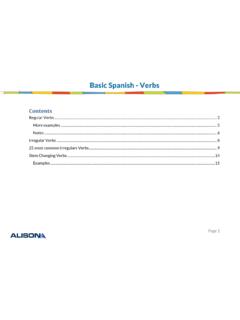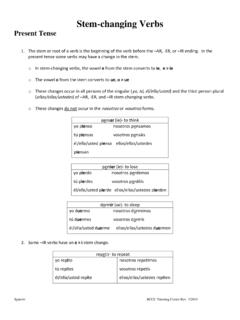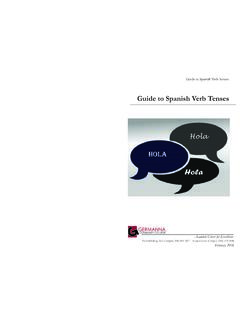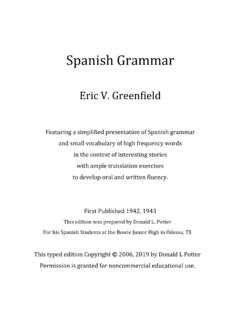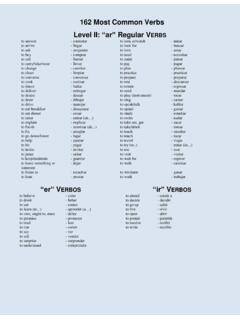Transcription of List of Top 10 Verbs in Spoken - Spanish for Your Job
1 QuickStart Spanish Conjugation Guide How to Use and Remember The 10 Most Common Verbs in Spoken SpanishWritten by Miguel Lira from Quickstart Spanish Conjugation Purpose of this Guide This guide is designed to help you identify, memorize and understand how to use the 10 Verbs most commonly used in Spoken Spanish . Although this guide will focus on the Spanish Spoken in Mexico (I m a native speaker) you can use it to speak Spanish all over the world. Why these Verbs ? Lets imagine you want to learn how to be a bartender quickly in order to get a job around town. Would you start by learning hundreds of drinks from around the world?, or would you find out which are the most popular drinks around your area, and learn those first?
2 Probably the second option, right? Like this, you d get the job and learn more as you go. The idea behind this list of Verbs is similar. Find out what s useful and used most often, so you can focus on that first to improve your Spanish faster. It s classic 80/20. The 80/20 Principle: According to Entrepreneur and Author, David Koch; The 80/20 Principle asserts that a minority of causes, inputs or efforts usually lead to a majority of the results, outputs or rewards (David Koch, The 80/20 Principle, Doubleday Publishing.) In other words, it s the few things that matter most. We can use the 80/20 Principle in Spanish to prioritize in order to move faster. In this case, by determining a segment of Verbs and words (which is usually around 20%) that are used most often in common conversations.
3 By focusing on that 20% you can get disproportionate results in the progress of your language skills. Quickstart Spanish Conjugation were these Verbs selected? The top 10 Verbs on this document were distilled from the list of 1000 word most frequently used in Spoken Spanish compiled by the brilliant Matthias Buchmeier, which has been generated from analyzing 6,527 subtitle files from TV series and movies with an approximate total of million words. You can learn more about Matthias findings over here: Lists of common words How to use this Guide , take a look at the table with the Top 10 Verbs used in Spoken Spanish . It will allow you to focus on the Verbs you will most often in conversations.
4 , learn the most common conjugations for the top 10 Verbs by looking at the Accelerated First Person Conjugation Table. It will help you move faster by expressing your own needs and desires. If you want to get started quickly without going deep, you can stop here. , when you are ready to move beyond the basics that will get you started quickly; take a look at the Conjugation Table with the Most Common tenses for the Top 10 Verbs in Spoken Spanish . It will help you understand and memorize the conjugations for the 7 most common tenses in everyday Spanish . Quickstart Spanish Conjugation this section, I will explain how to use the verb table you will find on the next page.
5 The 1st and 2nd column show the Verbs sorted by frequency in their raw infinitive form. The Verbs that are used most often are shown first. The 3rd column shows the approximate pronunciation of each verb , using the pronunciation of English as a guideline. The 4th column displays the meaning of each verb in English. The 5th column (and this is an important one) shows a Mnemonic sentence for each verb . Mnemonics are mental associations designed to help you memorize new information quickly. When you read each mnemonic sentence, imagine a mental image that is as vivid as possible, including colors, sounds, smells, textures, exaggerated sizes, shapes and even people you know or famous personalities.
6 Don t worry if it feels like a crazy dream. The more original and unique you make it, the easier it will be to remember. The 6th column has a few notes that explain each mnemonic to make sure the mental association is clear (be flexible and have fun. It s all about using your imagination!) The 7th column displays an sample sentence of each verb using a first person present tense conjugation. After you learn the Top 10 Verbs shown on the next page, you can start creating sentences using these shortcuts: Talking about the FUTURE Talking about the PAST Accelerated Memorization Table of Top 10 Verbs used in Spoken Spanish Quickstart Spanish Conjugation PronunciationMeaningMnemonicNotes about MnemonicSample Sentence1ser sehr to be (permanent)I AM a SIR according to the QueenThe word Sir sounds similar to ser" in Spanish , which means to be" and is used for characteristics that are permanent and un ser humano I am a human being2estar eh-star to be (temporary)STARS ARE always moving in the skyThe verb Estar also means to be and it is used to talk about non-permanent characteristics.
7 This temporary nature is similar to the position STARS hold in the sky as they move during the night. Also, the word STAR sounds similar to the verb estar in en casa I am at home3ir eer to goI GO to IReland for bEERThe verb to go" in Spanish , is IR and its spelling is included in the word IReland and its approximate pronunciation is contained in the last 4 letters of the word bEER Yo voy a mi trabajo I go to my job 4haber ah-behr"to have (auxiliary)I HAVE seen A BEAR todayIn Spanish , Haber is the auxiliary verb to have which is used for conjugations (as in I have seen ) and the phrase A BEAR sounds similar to Haber Yo he estudiado I have studied5tener teh-nehr"to have (something)
8 I HAVE TEN ER doctors helping meIn Spanish , Tener means to have and it is used mostly for things you can hold or own. The phrase TEN ER doctors includes the spelling of Tener Yo tengo tiempo I have time6saber sah-behr to know (knowledge)I KNOW Winnie the Pooh iS A BEARThe second half of the phrase Pooh iS A BEAR contains the pronunciation of the verb Saber which means To know in Spanish . Yo s poco Espa ol I know a little Spanish7poder poh-dehr to be able toI CAN put the flower POT THERE POT THERE sound similar to Poder which means to be able to in puedo pensar r pido I can think quickly8querer keh-rehr to wantA CARE BEAR always WANTS a hug!
9 CARE BEAR sounds a little similar to Querer which means To want in SpanishYo quiero una ensalada I want a salad9hacer ah-sehr to doI DO A SERvice for the community everydayThe first 4 letters of the phrase A SER vice sound similar to Hacer which means To do in SpanishYo hago muchas cosas I do many things10ver behr"to seeI SEE a BEARThe word BEAR sounds similar to Ver which means To see in SpanishYo veo la televisi n I watch televisionAccelerated Memorization Table of the Top 10 Verbs used in Spoken Spanish Quickstart Spanish Conjugation this section, we ll learn how to use the 1st person conjugation table available on the next page.
10 The 1st and 2nd column show the Verbs sorted by frequency in their raw infinitive form. The 3rd column displays the meaning of each verb in English. The 4th column shows the ending they have in the infinitive form (ar, er, ir) The 5th column shows the 1st person conjugation for the present tense. The 6th column shows the 1st person conjugation for the preterite tense. The 7th column shows the 1st person conjugation for the imperfect tense. The 8th column shows the 1st person conjugation for the conditional tense. The 9th column shows the 1st person conjugation for the future tense. The 10th column shows the 1st person conjugation for the present perfect tense.
